Alcohol (RCH2 – OH):
Alcohols are the class of organic compounds containing one or more hydroxyl groups attached directly to carbon atoms. Alcohols may thus be regarded as derivatives of water in which one hydrogen atom has been replaced by an alkyl group. Compounds with one –OH group are called monohydric alcohols; those with more than one are di-, tri- and polyhydric alcohols. The general formula of monohydric alcohols is CnH2n+1-OH.
Monohydric alcohols:

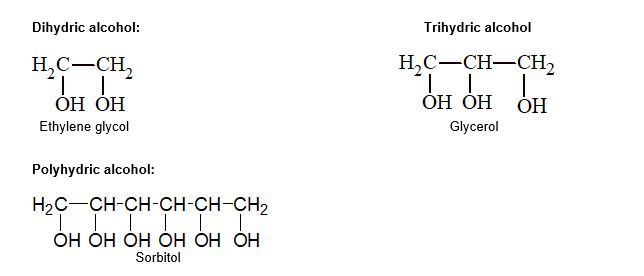
[Note: Generally, polyhydric alcohols are derived from sugars.]
IUPAC nomenclature: IUPAC name of alcohols is alkanol.
Isomerism: Alcohols exhibit chain, position and functional isomerism.
Illustration 1: Which of the following is a primary alcohol?
(A) Butan-2-ol
(B) Butan-1-ol
(C) Propan -2-ol
(D) 2-dimethylhexane-4-ol
Solution: (B)
METHODS OF PREPARATION OF ALCOHOLS (Specially Ethylalcohol):
1) From Alkene:
(i) Hydration method:

(ii) Hydroboration – oxidation method:

(iii) Oxymercuration – demercuration method:

2) From Alkyne:

3) From Alkyl Halide:
alkyl halides are hydrolysed by aqueous alkalies or moist silver oxide to give alcohols respectively.
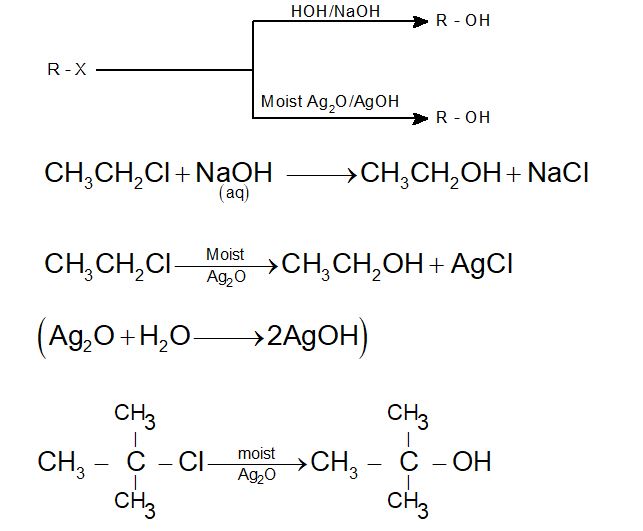
4) Reduction Methods:
(i) Reduction of carbonyl compounds:
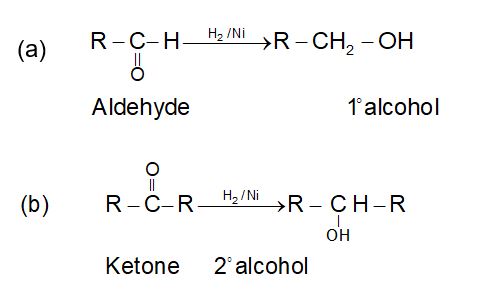
The drawback of reduction with H2/Ni is that double bonds and triple bonds are also reduced.
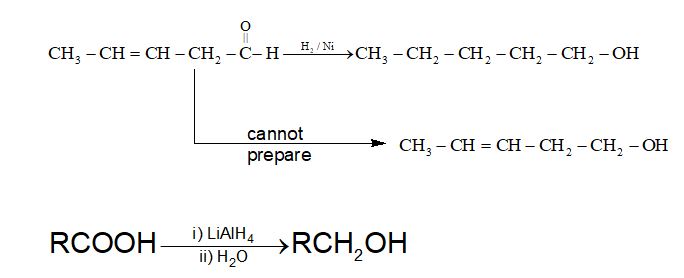
Reduction by LiAlH4 or NaBH4: Aldehydes, ketones, esters, amides and halides are reduced by LiAlH4 to alcohols. Aldehydes and ketones are also reduced by NaBH4.
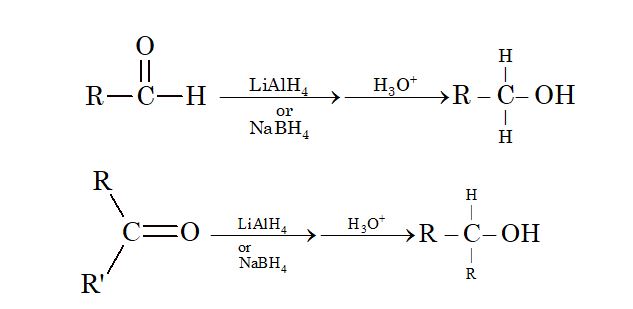
5) From Grignard Reagent:
(i) Formation of primary alcohol: Grignard reagent reacts with formaldehyde and epoxy ethane to form primary alcohol.

(ii) Formation of secondary alcohol: Grignard reagent reacts with acetaldehyde and ethyl format to gives secondary alcohol.
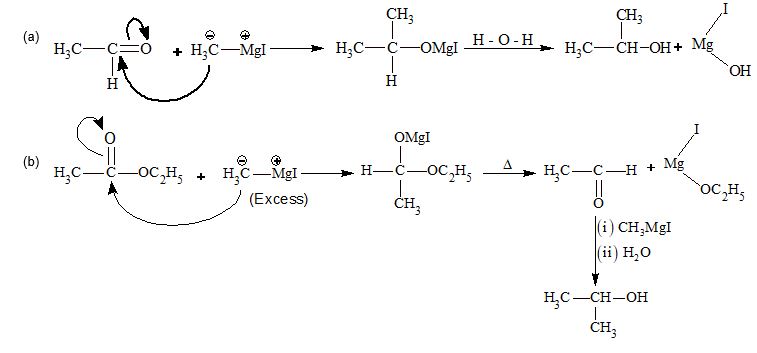
(iii) Formation of tertiary alcohol:

6) From Ethyl Acetate:
7) By fermentation: Slow decomposition of a complex organic compound into simpler compounds by means of micro organisms such as yeast, a single celled micro organism. (e.g., yeast)
i) From starch: Common sources of starch are wheat, barley, potato etc. The grain is mashed with hot water. It is then heated with freshly germinated barley (malt) at 500C for 1 hour. Malt contains the enzyme diastase. Diastase converts starch into the sugar, maltose by hydrolysis. This maltose on fermentation (24 – 72 hours) in presence of maltase enzyme (produced by yeast) gives glucose.
ii) From molasses: Molasses is the mother liquor left behind after the crystallization of sugar from sugarcane juice. It contains about 30 – 40% uncrystallised sucrose. This dark syrupy liquid is diluted with water to have the percentage of sugar in the solution to about 10%. To this diluted molasses solution H2SO4 is added to maintain the pH of the solution at 4. Ammonium sulphate and ammonium phosphate are added as food for the yeast.
Yeast ferment with sugar solution for 24 – 72 hours and converts it into glucose and fructose and finally into ethyl alcohol.
(Invertage and zymase enzymes are produced by yeast and function as biocatalyst in fermentation process).
Rectified spirit:
The glucose or fructose fermented liquor known as wash or wort contains 6 to 10% ethyl alcohol. It is subjected to fractional distillation to get 93 to 95% (w/w) ethyl alcohol known as rectified spirit. Generally 95% aqueous alcohol is called rectified spirit. Rectified spirit is also called industrial alcohol.
Methylated spirit:
The industrial alcohol is denatured (denature means to make it unfit for drinking), then it is called methylated spirit. Methylated sprit is of two kinds:
i) Mineralised methylated spirit : is 90% rectified spirit + 9% methyl alcohol and + 1% petroleum and purple dye.
ii) Industrial methylated spirit: is 95% rectified spirit and 5% methyl alcohol.
Absolute alcohol: is 99.5% to 100% pure ethyl alcohol. It is obtained by distillation of rectified spirit over calcium oxide and then over.
Industrial preparation of methyl alcohol:
Illustration 2:
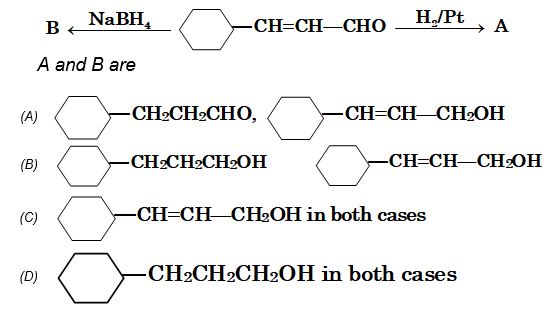
Solution: (B). NaBH4 clearly reduces carbonyl group.
Illustration 3: HO – CH2 – CH2 –– Ph A
A is
(A) primary alcohol
(B) secondary alcohol
(C) tertiary alcohol
(D) diol
Solution: (C)
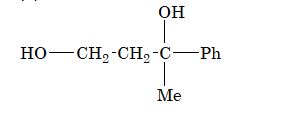
Illustration 4: Ester
Alcohol B reacts fastest with Lucas reagent. Hence, A and B are
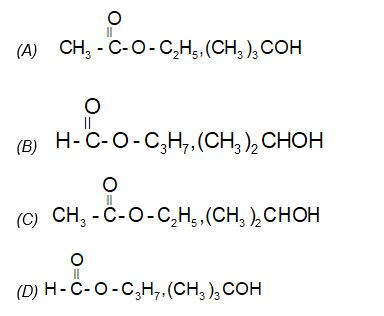
Solution: (A).

It is a 3° alcohol which reacts fastest with Lucas reagent.
Physical Properties of ethyl alcohol:
i) Ethyl alcohol is colourless is inflammable sweet smelling liquid.
ii) It is miscible with water in all proportions because of intermolecular hydrogen bonding and is also miscible with organic solvent due to nonpolar ethyl group.
iii) Its boiling point is 78.10C.
Chemical properties of alcohols (specially ethylalcohol):
Alcohols are reactive compounds mainly due to the presence of hydroxyl group. The reactions can be broadly divided into three categories, namely,
1. reactions involving the cleavage of C – OH bond
2. reactions involving the cleavage of O – H bond
3. reactions involving the cleavage of both alkyl and hydroxyl group
1) Reactions Involving the Cleavage of C – OH Bond:
(i) Reaction with PCl5, PCl3 and SOCl2:
(a)
(b)
(c)
[Note: HCl is dissolved in pyridine and SO2 escapes out. Hence, pure alkyl halide is formed.]
(ii) Reaction with ammonia:
2) Reactions Involving the Cleavage of O – H Bond:
(i) Reaction with metals: Alcohol reacts with metal to form alkoxide and hydrogen gas is released.
(ii) Reaction with organic acids: Alcohol reacts with organic acids to form esters. The process is known as esterification.

Mechanism of acid catalysed esterification:
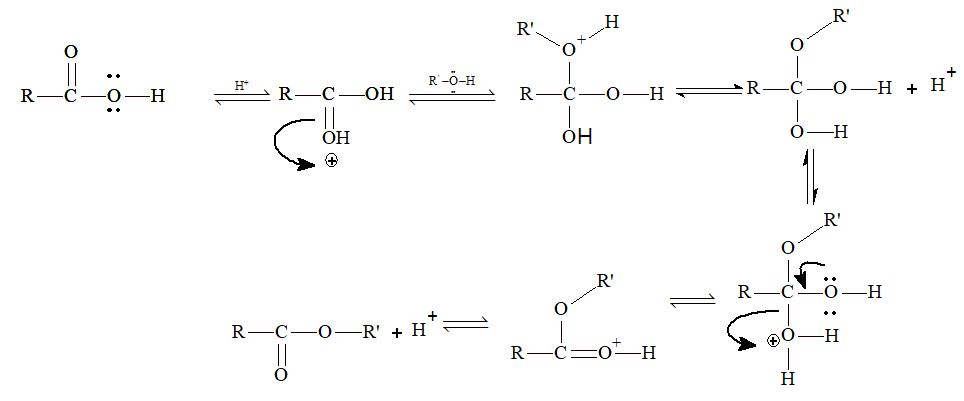
(iii) Reaction with inorganic acids: Alcohols react with inorganic acids to form inorganic esters.
(iv) Alkylation:
When alcohols react with dialkyl sulphates, the hydrogen of the hydroxyl group is replaced by an alkyl group resulting in the formation of ether.
3) Reactions Involving the Cleavage of both Alkyl and Hydroxyl Group:
(i) Oxidation:
The oxidation of alcohol depends upon the nature of alcohol. The oxidizing agents usually employed are: acidified potassium dichromate (K2Cr2O7), acidified or alkaline potassium permanganate or dilute nitric acid.
a) Oxidation of primary alcohol: A primary alcohol is easily oxidized to an aldehyde and then to carboxylic acid.
b) Oxidation of secondary alcohol: On oxidation, secondary alcohol forms ketone.

[Note: Beside above mentioned oxidizing agents, few other mild oxidizing agents are also used, viz., X2, Fenton’s reagent [FeSO4/H2O2], acidic K2Cr2O7, Jones reagent (CrO3/PCC), Cu/300oC.]
Tertiary alcohols give ketone of less no. of carbon atoms:

Tertiary alcohols gives alkene with Cu/3000C:

(ii) Dehydration:
Alcohols on dehydration (elimination of water molecule) forms alkene. Dehydration takes place easily in case of tertiary alcohol in comparison to primary alcohol.
(a)
Mechanism:
(b) 

Pinacol–pinacolone rearrangement: Pinacols on treatment with mineral acids loses a molecule of water and rearranges to form pinacolone.

Illustration 5: Each of the following alcohol gives ketone on oxidation except
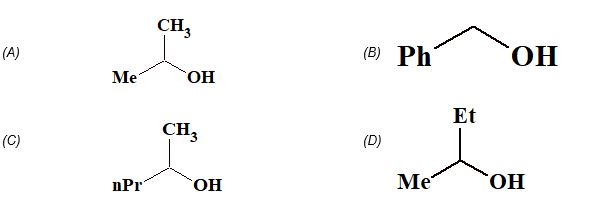
Solution: (B) It will give benzaldehyde on oxidation.
Identification of primary, secondary, tertiary alcohols:
1) Lucas Test: No reaction.
reacts within five minutes.
reacts within 30 seconds.
2) Victor Meyer’s Test:
10 alcohol red colouration.
20 alcohol blue colouration.
30 alcohol no reaction (no colour).
Uses of methyl alcohol:
i) As a solvent for pains and varnishes.
ii) In the preparation of formaldehyde, perfumes and dyes.
iii) In the preparation of methylated spirit.
Uses of ethyl alcohol:
i) As a solvent for pharmaceutical preparations, pains, perfumes, varnishes, gum.
ii) As alcoholic beverage.
iii) as a preservative for biological specimens
iv) As an antifreeze for automobile radiators
v) As fuel in spirit lamps, stove etc.
vi) As a source for the preparation of acetaldehyde, chloral, chloroform, iodoform, acetic acid, ether etc.
Preparation of wine:
Grapes are the source of sugar and yeast. Sugar increases in ripe grapes and yeast grows on the outer skin. On crushing the grapes, sugar and the enzyme come in contact and fermentation starts in anaerobic conditions. If air is present in oxidieses alcohols to acids.
ETHERS (R – O – R):
A class of organic compounds which contain C–O–C linkage, i.e. these are derivatives of water (H–O–H) where both the hydrogen atoms are replaced by alkyl or aryl groups. Ethers which contain two identical alkyl or aryl groups are called symmetrical ethers, and those containing two different groups are termed as unsymmetrical ethers. Some ethers are given below:
IUPAC nomenclature: Alkoxy alkane. e.g.,
Methods of Preparation Ethers:
1) From Alcohols:
(i) Primary alcohols on dehydration with conc. H2SO4 at lower temperature form ether.
[Note: Lower temperature favours the formation of ether whereas higher temperature favours the formation of alkene.]
Mechanism:

(ii) Alcohol reacts with diazomethane to give alkyl methyl ether.
2) From Sodium Alkoxide (Williamson Synthesis)
A nucleophilic substitution reaction between sodium alkoxide and alkyl halide gives ether. It is known as Williamson synthesis.
[Note: (i) Alkyl halide should be primary because secondary and tertiary alkyl halides undergo dehydrohalogenation in the presence of , which is a strong base and follows elimination reaction.
(ii) Vinyl halide and aryl halides are not used due to their low reactivity.]
3) From Ethyl Bromide:
Physical Properties of Ethers:
i) Lower members are gases or volatile liquids, e.g. ,
ii) They are colourless liquids with pleasant ethereal odour.
iii) Ether vapours are highly inflammable. Ether fire is extinguished by CO2 or pyrene (CCl4) extinguisher and not by water as ether floats on water.
iv) Dipole nature: The C – O bond in ether is polar in nature as oxygen is more electronegative than carbon atom. They have a dipole moment of 1.15 -1.30 D. The two C – O bonds are inclined at an angle of 110o, hence two dipoles do not cancel each other and makes ether somewhat polar.
v) Boiling points: Ethers are isomeric with alcohols, but their boiling points are much lower than those of the isomeric alcohols as ethers do not form intermolecular hydrogen bonding.
vi) Solubility: Ethers containing upto three carbon atoms are soluble in water due to the formation of hydrogen bonds between water and ether molecules.
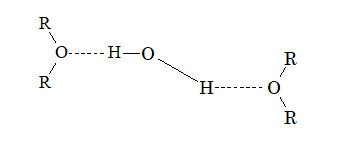
Chemical Properties of Ethers:
1) Nucleophilic substitution reactions: Ether reacts differently with cold and hot HI.
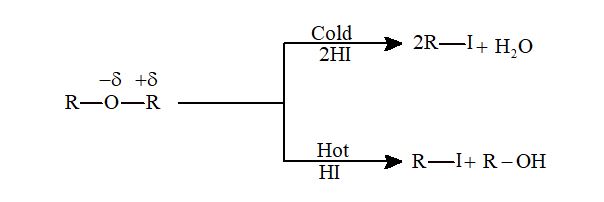
Mechanism:

[Note: (i)In presence of a strong nucleophile, the primary or secondary carbon atom of ether molecule follows SN2 mechanism and the nucleophile attacks the less hindered carbon atom to give the less substituted alkyl iodide and the more substituted alcohol.

(ii) If the reaction is carried out in presence of excess of reagent, the byproduct alcohol (formed) gets converted into the corresponding halide.
(iii) Reaction of ether with HI is used for the estimation of alkoxy groups and the method is known as ‘Zeisel’ method.]
2) Halogenation:
a) α – H atoms are displaced by Cl atoms, when halogenation takes place in dark.

(b) When halogenation takes place in presence of light and excess of halogen, all the H atoms are displaced by Cl atoms.

3. Electrophilic substitution of ethers : ‘OR’ is a ortho and para directing group.
a) Bromination
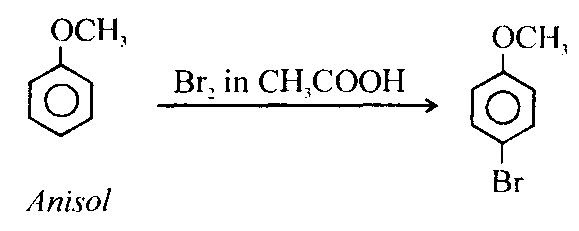
b) Methylation

c) Nitration:

Uses of Diethylether:
i) As a general anesthetic e.g., Enthrane and isoflurane.
ii) As a refrigerant
iii) As a substitute for petrol after mixing with ethyl alcohol under the trade name natalite.
Illustration 6: The less polar solvent among the following is
(A) CH3CO2H (B) CH3OH (C) CH3OCH3 (D) CH3COCH3
Solution: (C) CH3OCH3
Illustration 7: Predict the major product

(A) HOCH2CH2CH2CH2I
(B) HOCH2CH2CH2CH2OH
(C) ICH2CH2CH2CH2I
(D) No reaction
Solution: C. Alcohol will further react with HI, as HI is in excess.
PHENOLS
The class of organic compounds in which hydroxyl group is directly linked to the benzene ring. Similarly, like alcohol phenols can be monohydric, dihydric and trihydric.
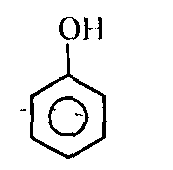 |
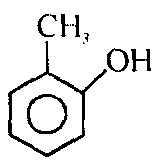 |
|
Phenol |
O-cresol (or 2-methyl phenol in IUPAC) |
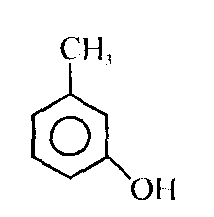 |
 |
|
m-cresol (or 3-methyl phenol in IUPAC) |
p-cresol (or 4-methyl phenol in IUPAC) |
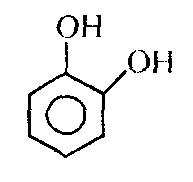 |
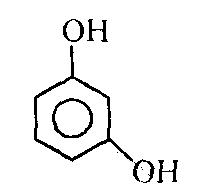 |
|
Catechol (or Benzene – 1, 2 –diol in IUPAC) |
Resorcinol or (benzene -1, 3-diol in IUPAC) |
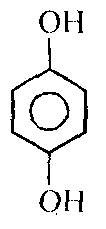 |
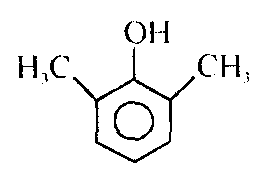 |
|
Hydroquinone or quinol (or benzene – 1, 4-diol in IUPAC) |
2, 6-dimethyl phenol (in IUPAC) |
METHODS OF PREPARATION
1) From Benzene Sulphonic Acid:
Benzensulphonic acid on fusion with NaOH gives sodium salt of phenols.

2) From Chlorobenzene (Dow’s Process)
This process involves alkaline hydrolysis of chlorobenzene.

3) Rasching’s Process:
4) From Benzene Diazonium Chloride:

5) From Grignard Reagent:
6) Oxidation of Benzene:
This is the latest method for the manufacture of phenol.
7) From cumene:

PHYSICAL PROPERTIES:
Phenol is a colourless, crystalline and deliquescent solid. It attains pink colour on exposure to air and light. It has a peculiar characteristic smell and a strong corrosive action on skin.
CHEMICAL PROPERTIES:
Acidic Nature of Phenol:
Phenol is a weak acid. The acidic nature of phenol is due to the formation of stable phenoxide ion in solution.
The phenoxide ion is stable due to resonance

The negative charge is spread throughout the benzene ring. This charge delocalization is a stabilizing factor in the phenoxide ion and increase acidity of phenol. Following reactions show acidic nature of phenol.
(i) Reaction with metal:
Reaction with alkali: Phenol reacts with strong alkalies to form phenoxide.
[Note: Phenol does not decompose Na2CO3 and NaHCO3, i.e. CO2 is not evolved because phenol is weaker than carbonic acid.]
Reactions of OH Group:
(i) Reaction with FeCl3: Phenol gives violet colouration with FeCl3 solution due to the formation of a coloured ion complex, which is a characteristic to the existence of keto-enol tautomerism.

(ii) Ether formation:
(iii) Ester formation (Schotten–Baumann reaction):
(a)
(b)
[Note: The phenyl esters on treatment with anhydrous AlCl3 undergoes Fries rearrangement to give o–and p–hydroxy ketones. ]
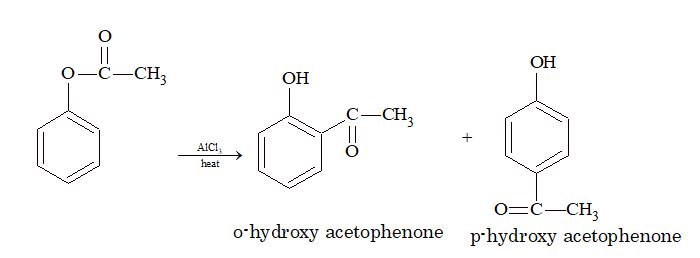
(iv) Reaction with PCl5:
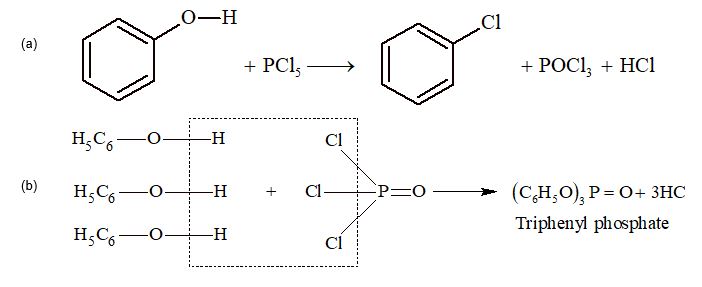
(v) Reaction with Zn dust:

(vi) Reaction with NH3(Bucherer reaction):

Reactions of Benzene Nucleus:
The –OH group is ortho and para directing. It activates the benzene nucleus.
(i) Halogenation (Bromination): Phenol reacts with Br2 water and decolourizes it whereas alcohols do not react. Phenol reacts with aqueous Br2 to give electrophilic substitution with immediate formation of a precipitate of 2,4,6-tribromophenol. In this reaction, water acts as a polar solvent.
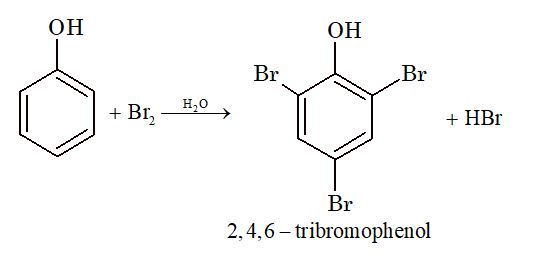
[Note: This is the basic reaction for a simple qualitative test for the detection of a phenol.
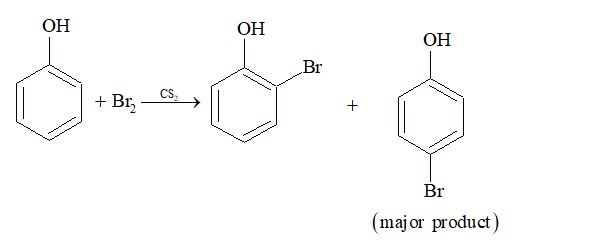
(ii) Sulphonation:
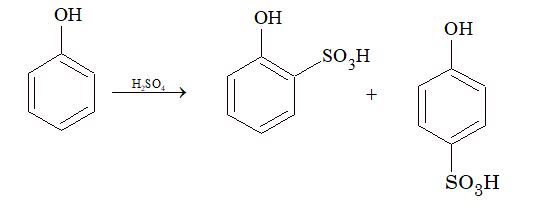
At low temperature(25C), the ortho-isomer is the major product, whereas at 100C, it gives mainly the para isomer.
(iii) Nitration: Phenol reacts with dilute HNO3 at 5-10C to form ortho and para nitro phenols, but the yield is poor due to oxidation of phenolic group.

When phenol is treated with concentrated HNO3 in presence of concentrated H2SO4, 2,4,6-trinitrophenol(picric acid) is formed.
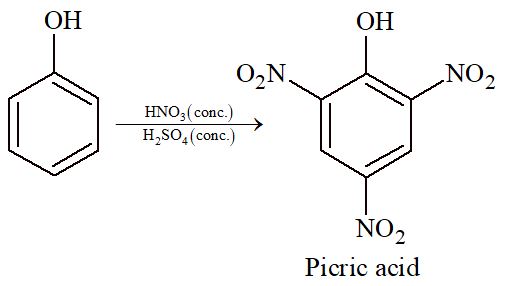
(iv) Nitrosation:
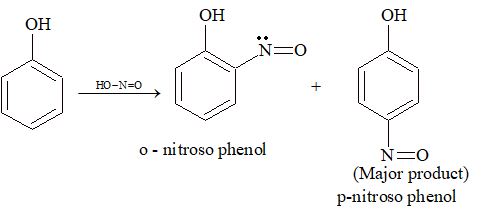
(v) Friedel–Crafts reaction:
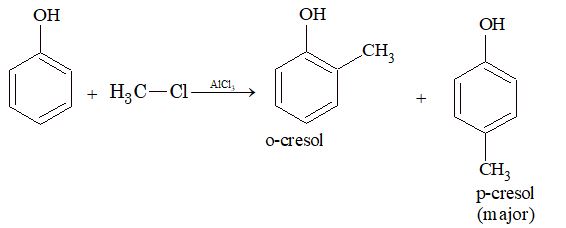
The above reaction is called alkylation.

The above reaction is called Friedel-Crafts acylation.
(vi) Reimer-Tiemann reaction: Treatment of phenol with chloroform in the presence of aqueous base followed by treatment with aqueous acid gives aldehyde.
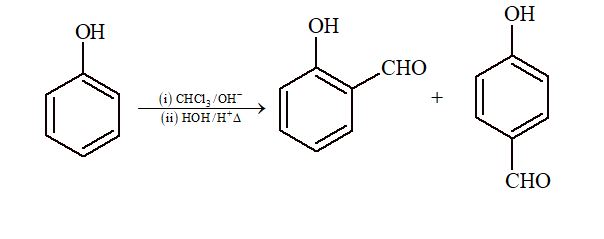
Mechanism:
The first step is -elimination of chloroform which gives a very reactive intermediate, dichlorocarbene as electrophile.
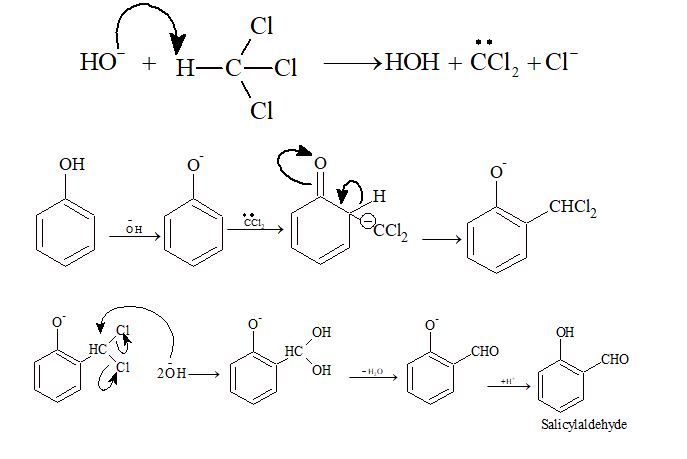
(vii) Reimer-Tiemann carboxylation:
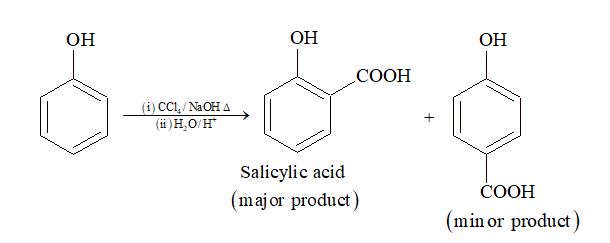
(viii) Gattermann’s reaction:
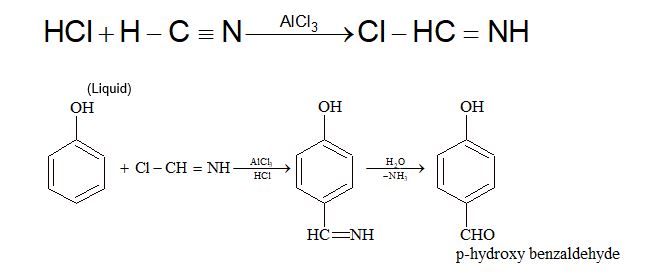
Miscellaneous Reactions:
Coupling reaction:
(a) Phenol couples with benzene diazonium chloride in presence of an alkaline solution to form a red dye (p-hydroxy azobenzene).

(b) Phenol couples with phthalic anhydride in presence of concentrated H2SO4 to form a dye, used as an indicator.
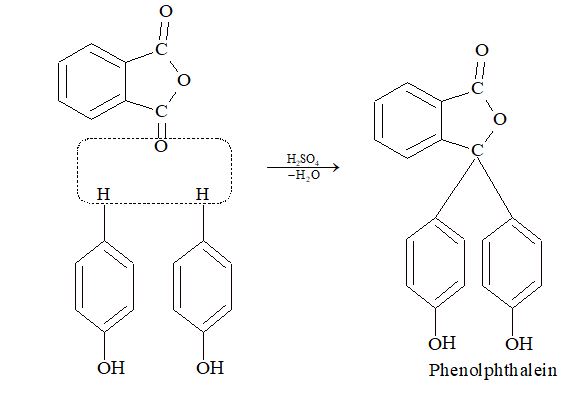
(ii) Oxidation Reaction: Phenols give different oxidation products with different oxidizing agents.
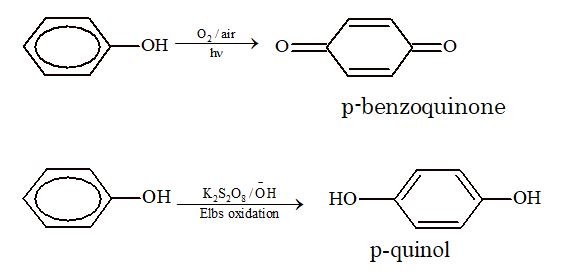
(iii) Condensation with formaldehyde: Phenol condenses with excess of formaldehyde in presence of sodium hydroxide or acid to form a polymer known as bakelite.This reaction is known as Lederer-Manasse reaction.
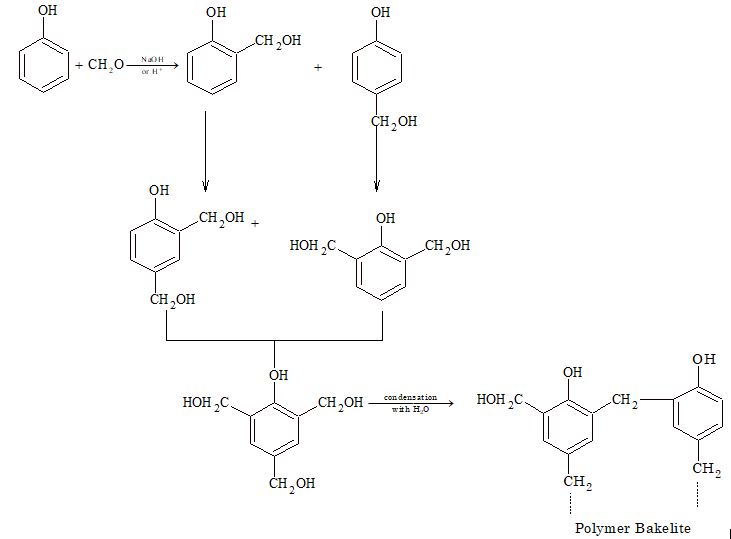
(iv) Liebermann’s nitroso reaction: When phenol is reacted with NaNO2 and concentrated H2SO4, it gives a deep green color, which changes to red on dilution with water. When made alkaline with NaOH, original deep green colour is restored.
Uses of phenol:
a) as a raw material for the manufacture of dyes , drugs pharmaceuticals, polymers (backelite) etc.
b) as a strong antiseptic
Illustration 8: Acidic nature is more for
(A) o-amino phenol
(B) m-amino phenol
(C) p-amino phenol
(D) All have equal Ka‘s
Solution: (B) –NH2 is electron donating group, at meta position the donation of electron will be least.
Illustration 9: Arrange the following in order of decreasing acidic strength:
p-nitrophenol (I), p-cresol (II), m-cresol (III), phenol (IV)
(A) I > IV > II > III
(B) III > II > I > IV
(C) II > IV > III > I
(D) IV > III > II > I
Solution: (A) NO2 group is electron withdrawing, and in cresol -CH3 group is electron releasing due to +I effect.
Illustration 10: When phenol is heated with CCl4 in alkaline KOH, it produces
(A) salicyldehyde
(B) salicylic acid
(C) p-chlorophenol
(D) none of these
Solution: (B)
Illustration 11: The end product in the following sequence of reaction is
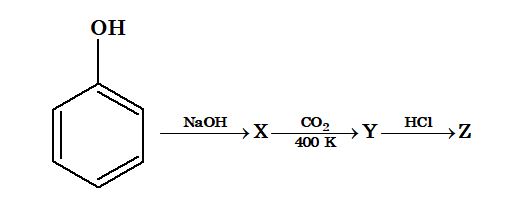
(A) salicylaldehyde
(B) benzoic acid
(C) p-chlorohydroxybenzene
(D) 2-hydroxybenzoic acid
Solution: (D).

FORMULAE AND CONCEPTS AT A GLANCE
1. Alcohols having only one –OH group are called monohydric alcohol, those having two –OH groups attached to two different C-atoms are called dihydric alcohols and similarly trihydric and polyhydric alcohols.
2. Alcohols in which –OH group is attached to a 1o-carbon atom are called primary alcohols (1o-alcohols), in which –OH group is attached to a 2o-Carbon are called secondary alcohols, and similarly tertiary alcohols.
3. Oxymercuration-demercuration (OMDM) is the process to convert alkenes into alcohols in accordance with Markovnikoff’s rule but without rearrangement.
4. Hydroboration-oxidation (HBO) is a process to convert an alkene into alcohols anti to Markovnikoff’s rule.
5. Alkyl halides can be converted into alcohols through hydrolysis, a case of nucleophilic substitution reaction (SN).
6. Aldehydes and ketones can be reduced into alcohols by using LiAlH4, NaBH4, Na/C2H5OH, H2/Ni etc.
7. Acid halides and esters can also be reduced into alcohols by reduction with LiAlH4.
8. Oxiranes react with Grignard’s reagents to give alcohols (monohydric), since nature of Grignard’s reagent is basic hence it attacks on the less hindered carbon of oxirane only.
9. Acidic properties of alcohols:
(i) Alcohols are weaker acids as they liberate H2 gas with Na metal.
(ii) Alcohols are weaker acids than water except methanol.
(iii) Correct order of acid strength is:
alcohols < water < phenol < carbonic acid < carboxylic acids < picric acid
10. Rate of esterification/acetylation ∝
11. PCC in CH2Cl2 oxidises 1o-alcohols to aldehydes while CrO3 in acetic acid, oxidizes 2o alcohols into ketones without affecting double or triple bond.
12. Jone’s reagent CrO3/H2SO4, cannot be used for the oxidation of acid sensitive compounds. It can oxidize 1o alcohol to aldehydes and 2o alcohol to ketones.
13. Dehydrogenation withCu/300oC, chains 1o alcohols to aldehydes, 2o alcohols to ketones but 3o alcohols to alkenes.
14. Like alcohols, phenols also shows acidic properties and their Ka value increases with some EWG and decreases, with ERG in aromatic ring.
15. With phthalic anhydride and conc. H2SO4, two molecules of phenol on condensation gives an important acid-base indicator, called phenolphthalein.
16. Ethers are regarded as alkyl derivative of alcohol i.e. H of –OH is replaced by some alkyl or aryl group (R–OR’).
17. Ethers are mainly prepared from alcohols using Williamson’s synthesis, dehydration at 140oC, addition on alkenes in presence of acid, methylation by CH2N2 etc.
18. Epoxides can be prepared by epoxidation i.e. oxidation of alkene by air (O2), MMPP or MCPBA or by heating a halo hydrin with NaOH.
19. Opening of epoxy ring occurs form the side of highly substituted carbon in acidic medium and form the side of less substituted carbon in basic medium.
SOLVED PROBLEMS-1
Prob 1: Arrange the following in increasing order of acid dissociation constant.

Sol: NO2 group exerts –R effect from o and p position. Therefore, the weakest acid (lowest acid dissociation constant) is compound (IV). More number of nitro group present, more is the acid strength. So, compound (III), due to three nitro group, is the strongest acid with highest acid dissociation constant. Out of I and II, I is weaker than II, due to intramolecular H-bonding. Thus correct order is IV < I < II < III
Prob 2: What would be the product in the following reaction?

Prob 3:
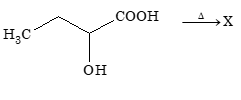
What will be the X in this reaction?
Sol:
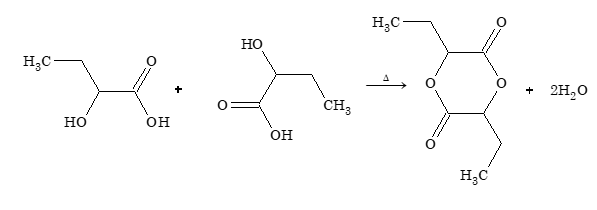
Prob 4:

Identify (B) in the above reaction
Sol:

Prob 5:
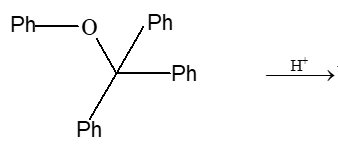
What is the product of this reaction?
Sol:

This carbocation attacks at the para position of phenol, thus product is
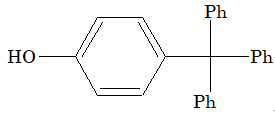
Prob 6: An organic compound (A) (molecular formula C4H10O), upon dehydrogenation gives a compound (B), which forms phenyl hydrazone with phenylhydrazine and both the compounds (A) and (B) respond to iodoform test. What are the compounds (A) & (B)
Sol:

Prob 7:
In the above reaction find (A) and (B)
Sol:
Thus, A is mixture of CH3I and (CH3)3COH and B is a mixture of CH3OH and (CH3)3CI
Prob 8: Arrange the following in increasing order of dipole moment.
CH3CH2CH3(I), CH3CH2OH (II) and CH3CH2F(III)
Sol: Higher the electronegativity between C–X bond, higher will be the dipole moment.
Thus, the increasing order of dipole moment is I < II < III.
Prob 9: Phenol is heated with phthalic anhydride in presence of conc. H2SO4. The product gives pink colour with alkali. What is the product
Sol:
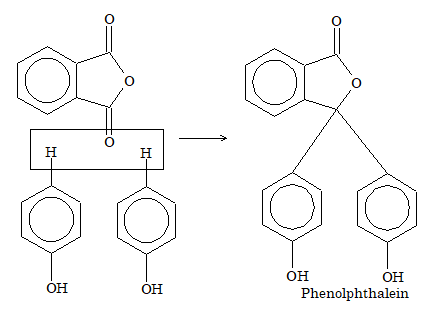
Prob 10:

What are A and B in the above reaction
Sol: In alkene, alkaline KMnO4 introduces two –OH at (C=C) and 3° alcohol is not oxidized by CrO3 thus, A and B are

SOLVED PROBLEMS-2
Prob 1:
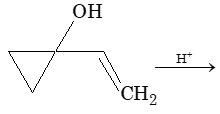 Major product of the reaction is
Major product of the reaction is

Sol:

This carbocation can be stabilized by resonance
Prob 2: In which of the following case configuration about chiral carbon is retained?

Sol: (A)

Prob 3:
A is
(A) (CH3)3C—CH=CH2
(B) (CH3)2C=C(CH3)2
(C) CH2=C—CH2—CH2CH3
(D) none of the above
Sol: (B). Intermediate which is formed during 1,2 methyl shift is 3° carbonium ion.
Prob 4:


Sol: (A). As we know stability of carbocation follows following order 3° > 2° > 1°.
Prob 5: Phenol is less acidic than
(A) ethanol (B) methanol (C) o-nitrophenol (D) p-cresol
Sol: (C). Nitro group is electron withdrawing group.
Prob 6: The product of dehydrogenation of methanol is converted by Tollen’s reagent to
(A) methanol (B) methanoic acid (C) both the above (D) none of the above
Sol: (B)
Prob 7: The boiling points of isomeric alcohols follow the order
(A) primary > secondary >tertiary
(B) tertiary > secondary > primary
(C) secondary > tertiary > primary
(D) does not follow any order
Sol: (A). van der Waals forces are responsible for boiling point.
Prob 8: By which of the following reactions can trans-cyclopentane-1,2-diol be obtained?

Sol: (C). As KMnO4 and OsO4 produce cis-diol.
Prob 9: The product obtained in the reaction
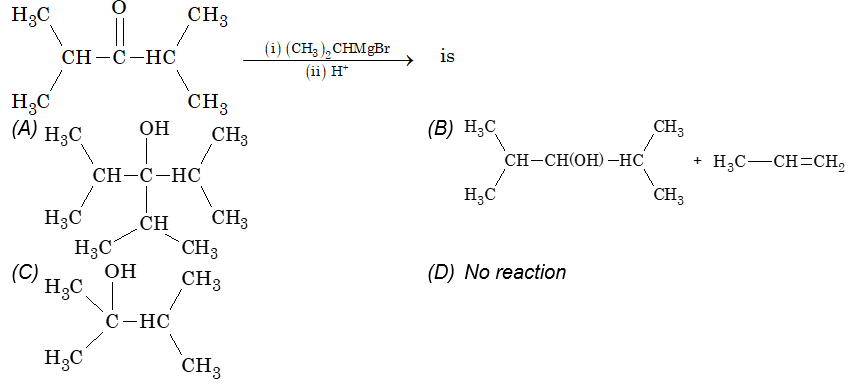
Sol: (B). Reason is steric hinderance
Prob 10: The final product obtained in the reaction

Sol: (A). The bond between O and sp2 hybrid C is strong due to resonance.








